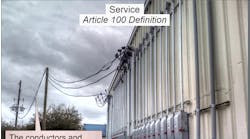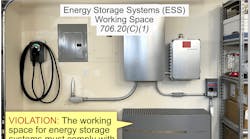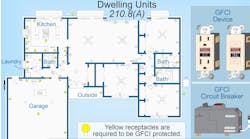Changes to the 2011 NEC affect how you supply power to a structure and protect the conductors carrying that power. Most of these changes are subtle, so understanding the new requirements isn’t particularly difficult. Nevertheless, service conductor requirements can present some “gotchas.”
For example, you apply different rules depending on whether a service conductor is inside or outside a building/structure. Getting inside versus outside right is not as straightforward as it may seem, so consult Sec. 230.6 before deciding — and make sure you understand the important terms within it.
Service conductors
In previous editions of the NEC, Part II of Art. 230 applied to “overhead service-drop conductors,” a term that’s no longer used. Only in instances where the customer owned these overhead conductors did this apply. In the rare instances these conductors fall within the scope of the Code, they’re now called “service conductors, overhead.”
A new exception (No. 5) in 230.24 permits lower clearances for overhead service conductors. If the voltage between conductors doesn’t exceed 300V — and the roof area is guarded or isolated — the normal 8-ft clearance needs to be only 3 ft.
The physical protection requirement for underground service conductors (230.32) now includes “structures” instead of just “buildings.” While all buildings are structures, not all structures are buildings. The language of Part IV, Sec. 230.40 now makes better use of defined terms. Additionally, it addresses multiple accessory structures in a better way. For example, previous NEC editions used the word “structure” in the singular, causing some inspectors to see Exception 3 as permitting only a dwelling unit plus one accessory building from a service. With “structures” used instead, the NEC makes it clear that a service may supply a dwelling unit and multiple accessory structures.
Wiring methods
The list of permitted wiring methods for service-entrance conductors grew from 16 to 19 [230.43], so you have three more raceway options — all of which are conduit (HDPE, NUCC, and RTRC).
RTRC was actually introduced in the 2008 NEC, but 230.43 didn’t list it for service entrance wiring. Because its physical characteristics make it appropriate for protecting service-entrance cables, it’s included in the 2011 revision.
Service equipment
The service disconnecting means now must be listed (not just marked) as suitable for use as service equipment [230.66]. “Suitable for use as service equipment” means, among other things, the disconnect has a main bonding jumper. Such a jumper allows you to make the neutral-to-case connection required in 250.24(C) and 250.142(A), as shown in Fig. 1.
Fig. 1. The service disconnecting means now must be listed (not just marked) as suitable for use as service equipment.
The Code has long required that service equipment be marked as being “suitable for use as service equipment.” While most people agreed this effectively requires the equipment to be listed, a literal reading of the NEC doesn’t require it. For example, a person using a marker could write “suitable for use as service equipment” on the equipment to satisfy the requirement. This change closed that loophole, making the requirement obvious and enforceable.
Service disconnect supply side
You can’t connect electrical equipment to the supply side of the service disconnect enclosure, except for the nine types listed in 230.82. One of these bears further discussion.
It makes no sense to protect your conductors if the building burns down. Thus, the NEC has long permitted installers to connect fire pump equipment upstream of the service equipment. This permission also applies to standby power systems. Previous NEC editions referred to this connection as a “tap.” That’s confusing, because of the definition of “tap conductors” in 240.2.
Although terms defined within articles (other than Art. 100) don’t apply to terms within other articles, this language produced considerable debate. Whatever this connection might be, it isn’t a “tap conductor” as defined in 240.2. The simple solution was to change “tap” to “connection,” which is what the NEC meant all along.
Overcurrent protection
Article 240 provides the requirements for selecting and installing overcurrent protection devices (OCPDs). Overcurrent exists when current exceeds the rating of equipment or the ampacity of a conductor. This can be due to an overload, short circuit, or ground fault [Art. 100]. An OCPD must be capable of opening a circuit when an overcurrent situation occurs, and its interrupting rating must be sufficient to avoid damage in fault conditions [110.9].
The general rule for overcurrent protection is that conductors must be protected per their ampacities at the point where they receive their supply [240.4 and 240.21]. Selecting the proper overcurrent protection for a specific circuit can become complicated, however, because many special cases deviate from this basic rule.
For example, several rules allow tap conductors in specific situations [240.21(B)]. You also must contend with the overcurrent protection limitations for small conductors [240.4(D)] and the rules for specific conductor applications found in other articles [see Table 240.4(G)]. Complicating matters further, Art. 240 limits where you can locate OCPDs [240.24].
Always review your intended design against Art. 240 requirements before specifying OCPDs or deciding where they go.
Circuit breaker as overcurrent device
You must provide each multiwire branch circuit with a means to disconnect simultaneously all ungrounded conductors at the origin of the branch circuit [210.4(B)]. You can do this by using individual single-pole circuit breakers with identified handle ties or a 2- or 3-pole breaker with a common internal trip [240.15(B)], as shown in Fig. 2.
Fig. 2. Individual 1-pole breakers with identified handle ties are permitted for a multiwire branch circuit that only supplies line-to-neutral loads.
This disconnection requirement was added to 210.4(B) in the 2008 NEC. Unfortunately, 240.15(B)(1) wasn’t updated to be consistent with it. The 2011 revision fixed that inconsistency.
The 2011 revision goes even further with updates along this line. Sections 240.15(B)(2) and (B)(3) have been changed to align the NEC with the product standards for circuit breakers, particularly UL 489. Per this standard and the UL Guide Information for Electrical Equipment (White Book) category DIVQ, handle ties may connect single-pole breakers together on a circuit rated no higher than 120V to ground. This change effectively requires 3-pole breakers for line-to-line loads rated 277/480V.
In addition, AFCI or GFCI circuit breakers for multiwire branch circuits must be of the 2-pole type (Fig. 3).
Fig. 3. AFCI and GFCI circuit breakers must be of the 2-pole type if they are used to protect multiwire branch circuits.
10-ft feeder taps
You can tap feeder conductors [240.21]; the requirements vary depending on the tap length. In 240.21, you’ll find requirements for taps:
- Up to 10 ft long.
- More than 10 ft but not more than 25 ft long.
- More than 25 ft long.
Of particular interest are the feeder tap conductors up to 10 ft long. As outlined in Fig. 4, you can install these without overcurrent protection at the tap location if they don’t extend beyond the equipment they supply and their ampacity is at least the:
- Calculated load per Art. 220, and
- Rating of the device or overcurrent device supplied by the tap conductors.
Fig. 4. Feeder tap conductors up to 10 ft long can be installed without overcurrent protection at the tap location.
If the conductors leave the enclosure or vault in which you make the tap, they must:
- Be installed in raceway.
- Have an ampacity not less than one-tenth of the rating of the overcurrent device that protects the feeder.
Previous NEC editions have required that the overcurrent device upstream of the feeder tap not exceed 10 times the ampacity of the conductor. The 2011 revision changes the wording to require that the conductor have an ampacity of not less than one-tenth the rating of the overcurrent device. This results in no technical change, but provides a section that’s easier to read. It also brings the NEC text into alignment with the existing text of 240.21(B)(2)(1).
No OCPDs in dorms
The prohibition of OCPDs in bathrooms now expressly applies to dormitories, which were added to the list in 240.24(E). Now it reads “…dwelling units, dormitories, and guest rooms or guest suites….”.
Why this change? The Code has long prohibited the installation of OCPDs in the bathrooms of dwelling units. Dormitories share similar usage characteristics with dwelling units. Because many dormitories already meet the definition of a dwelling unit, this change may not be as significant as it appears.
Something that is significant, however — and surprisingly crops up as an installed Code violation — is locating the service disconnecting means in a bathroom. This is prohibited not just in dwellings, but also in commercial or industrial facilities [230.70(A)(2)].
Keeping it straight
This seems like a lot of detail, and the requirements have changed yet again. How can you possibly keep all this straight? For services, begin with Figure 230.1 in the NEC and work methodically through the applicable parts.
Article 230 doesn’t have such a handy figure for overcurrent protection requirements, but the logical arrangement of its nine parts makes it obvious which ones apply to a particular installation. Finally, don’t forget to put together a good one-line drawing before you start bolting equipment down.



